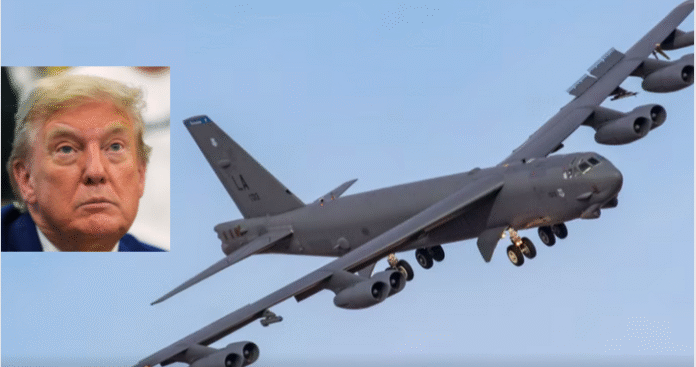Key Point Summary – Trump Approves Iran Attack Plans
- Trump signed off on Iran strike options but paused for diplomacy
- Fordow nuclear site seen as potential U.S. bunker buster target
- Iran’s Khamenei warns of “irreparable” retaliation if attacked
- U.S. adds Navy destroyer and second carrier to regional force
- Israel strikes 48 Iranian military sites; death toll tops 450 in Iran
- 24 dead in Israel from Iranian missile attacks
- U.S. Embassy in Israel begins evacuation flights for Americans
The Plan Is Locked
President Donald Trump has already approved strike plans against Iran’s nuclear facilities—but he’s waiting.
Late Tuesday night, Trump told his top aides that the attack greenlight was ready, yet he wanted to give Iran one final chance to abandon its nuclear program.
“I may do it. I may not do it,” Trump told reporters bluntly. “The next week is going to be very big—maybe even less than a week.”
But deep inside the Pentagon, one name keeps echoing: Fordow. The facility sits hidden beneath a mountain and is considered immune to most conventional weapons.
The only way in? A bunker buster. And America has those.
Trump Approves Iran Attack Plans But Hits Pause
Trump’s demand remains unchanged: unconditional surrender.
He’s made it clear that Iran must abandon enrichment or face consequences. But Supreme Leader Ayatollah Ali Khamenei is not blinking.
In a fiery statement, Khamenei vowed Iran would never surrender, warning that any U.S. military action would spark “irreparable consequences.”
So Trump waits, with his hand hovering over history’s trigger.
U.S. Forces Take Position
Behind the scenes, the military isn’t waiting.
A third Navy destroyer has entered the eastern Mediterranean. At the same time, a second U.S. carrier strike group is racing toward the Arabian Sea.
The Pentagon calls this buildup “defensive,” but the strategic position is anything but passive.
With bombers fueled and warships circling, the pieces are clearly in place should Trump give the go.
Israel Launches Relentless Assault
Meanwhile, Israel is not waiting.
Prime Minister Benjamin Netanyahu confirmed that Israel is pushing “step by step” to dismantle Iran’s nuclear ambitions and missile systems.
In a single 24-hour blitz, Israeli forces destroyed eight Iranian attack helicopters and 40 missile-related structures in western Iran.
Netanyahu made his intentions clear: “We will eliminate this threat. Piece by piece.”
Casualties Mount on Both Sides
According to human-rights monitors, the death toll inside Iran has now passed 450, as Israel’s strikes increase in scope and intensity.
In Israel, 24 civilians have died from recent Iranian retaliatory attacks. Missile sirens continue to wail across Tel Aviv, Haifa, and border towns.
U.S. Readies for the Fallout
At the same time, the U.S. Embassy in Israel has started emergency evacuation flights for American citizens.
U.S. Ambassador Mike Huckabee confirmed that the embassy is now coordinating flights out of Tel Aviv for those fleeing the conflict.
“We’re making sure every American who wants to leave, can,” Huckabee said.
Cruz Calls for Fordow Strike
Back in Washington, Senator Ted Cruz is one of the loudest voices calling for action.
“There’s no need for boots on the ground,” Cruz said. “But if Fordow is on the table, we have the tools. Let’s use them.”
Cruz recently clashed with conservative pundit Tucker Carlson over the issue, but the senator insists the time for debate is over.
Fordow: Iran’s Hidden Fortress
Built into the side of a mountain near Qom, Fordow is one of Iran’s most heavily guarded nuclear sites.
Experts believe it’s designed to withstand all but the most powerful strikes. However, the U.S. arsenal includes Massive Ordnance Penetrators (MOPs) capable of reaching such depths.
A successful strike on Fordow could cripple Iran’s nuclear program overnight—but at what cost?
Diplomacy Hanging by a Thread
While missiles fly and warships maneuver, diplomats cling to hope.
Oman has hosted secret talks in recent weeks. Yet Iran’s defiance and Trump’s blunt posture have left little room for compromise.
Europe continues to push for negotiations. But as one French diplomat said off record, “The train is speeding up—and no one knows where the brakes are.”
Public Split Over Possible Strike
Inside the U.S., public opinion is sharply divided.
On one side, many believe the time to act is now. “Hit Fordow before they finish the bomb,” one social media user posted.
Others beg for restraint. “Don’t start another war over a shadow,” read another post that’s now gone viral.
Protests are flaring in cities from D.C. to San Francisco. Americans are bracing for what may come next.
Israeli Confidence, Iranian Silence
While Iran stays quiet on the international stage, Israel appears emboldened.
Israeli officials insist they can win this war—with or without American firepower.
Yet few doubt the impact if the U.S. joins in. A joint U.S.–Israeli strike would likely overwhelm Iranian defenses—and unleash regional chaos.
Pentagon Holds Its Breath
Top generals continue to meet with Trump behind closed doors.
Every movement in the Gulf is tracked. Every Iranian radar ping is recorded. The White House remains silent. But the Situation Room is anything but calm.
Sources say Trump is demanding real-time updates around the clock.
Final Countdown
Trump’s pause may be short-lived. If Iran doesn’t bend, the order may come with no warning.
The jets are ready. The Navy is in position. The bunker busters are loaded.
And the world watches—knowing that with one command, the Middle East could ignite beyond control.




